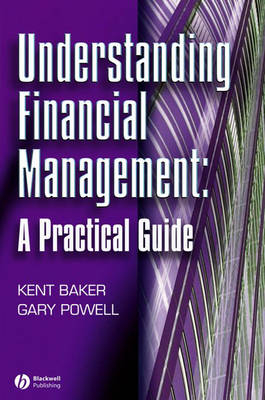
Understanding Financial Management
Wiley-Blackwell (Verlag)
978-0-631-23100-4 (ISBN)
Bridging the gap between financial theory and practice, the authors present fundamental concepts in an intuitive and nontechnical way, and provide numerous practical financial tips to readers. The focus is on current practice, using results from recent surveys to show the most popular techniques and approaches used by financial managers today.
A range of instructor’s resources are available at the accompanying website. Visit www.blackwellpublishing.com/baker for full details.
H. Kent Baker, University Professor of Finance, is the author of more than 150 articles for academic and professional journals including the Journal of Finance, Financial Management, The Financial Review, Journal of Financial Research, the Journal of Economics and Business, Harvard Business Review and many others. Gary E. Powell is an Associate Professor of Finance at Towson University.
List of Figures ix
List of Tables xi
About the Authors xiv
Preface xvi
Acknowledgments xx
Part I The Foundation 1
Chapter 1 Introduction to Financial Management 3
1.1 Financial Management and the Financial Manager 4
1.2 Corporate Form of Business Organization 8
1.3 The Goal of Financial Management 10
1.4 Accounting Profit versus Economic Profit 12
1.5 The Agency Relationship 14
1.6 Organization of the Book 15
Chapter 2 Interpreting Financial Statements 18
2.1 Basics of Annual Reports and Financial Statements 18
2.2 Balance Sheet 20
2.3 Income Statement 25
2.4 Statement of Cash Flows 31
2.5 Statement of Retained Earnings 35
2.6 Common-size Statements 35
2.7 Notes to Financial Statements 39
2.8 Quality of Earnings 40
2.9 Other Issues 41
Chapter 3 Interpreting Financial Ratios 45
3.1 Financial Ratio Analysis 46
3.2 Liquidity Ratios 47
3.3 Debt Management Ratios 52
3.4 Asset Management Ratios 56
3.5 Profitability Ratios 61
3.6 Market Value Ratios 66
3.7 Uses of Financial Ratios 69
3.8 Limitations of Financial Ratio Analysis 70
Chapter 4 The Time Value of Money 73
4.1 Central Concepts in Finance 74
4.2 Future Value of a Present Amount 75
4.3 Present Value of a Future Amount 80
4.4 Future Value of an Annuity 83
4.5 Present Value of an Annuity 86
4.6 Present Value of a Perpetuity 91
4.7 Compounding Frequencies 91
4.8 Nominal and Effective Interest Rates 94
4.9 Solving for an Unknown Interest Rate 95
4.10 Other Time Value Applications 98
Chapter 5 Valuation 103
5.1 Valuation Fundamentals 104
5.2 Bond Characteristics and Features 110
5.3 Bond Valuation 115
5.4 Bond Pricing Relationships 121
5.5 Interest Rate Risk 126
5.6 Bond Yields 129
5.7 Bond Trading and Price Reporting 134
5.8 Preferred Stock Features and Valuation 136
5.9 Common Stock Characteristics and Features 140
5.10 Common Stock Valuation 142
Part II Working Capital Management Decisions 155
Chapter 6 Working Capital Management 157
6.1 Introduction to Working Capital Management 158
6.2 Approaches to Working Capital Management 159
6.3 Operating and Cash Conversion Cycles 163
6.4 Cash Management 165
6.5 Accounts Receivable Management 177
6.6 Inventory Management 181
Part III Long-term Investment Decisions 189
Chapter 7 Capital Investments and Cash Flow Analysis 191
7.1 Capital Investment Decisions 192
7.2 Project Classifications 194
7.3 Capital Budgeting Process 195
7.4 Guidelines for Estimating Project Cash Flows 199
7.5 Cash Flow Components 205
7.6 Tax Effects of Selling Depreciable Assets 214
7.7 Applying Cash Flow Analysis 217
7.8 Capital Budgeting for the Multinational Corporation 221
Chapter 8 Capital Budgeting 227
8.1 Project Classifications and Analysis 228
8.2 Net Present Value 230
8.3 Profitability Index 235
8.4 Internal Rate of Return 238
8.5 Modified Internal Rate of Return 242
8.6 Payback Period 246
8.7 Discounted Payback Period 250
8.8 Summary of Capital Budgeting Techniques 252
8.9 Mutually Exclusive Project Decisions 254
8.10 Capital Rationing Decisions 269
8.11 Capital Budgeting Techniques in Theory and Practice 272
Chapter 9 Risk Analysis 278
9.1 Types of Risk in Capital Budgeting 279
9.2 Assessing Single-Project Risk 285
9.3 Assessing Market Risk 294
9.4 Adjusting for Risk 302
9.5 Risk Analysis in Multinational Corporations 313
9.6 Risk Analysis in Theory and Practice 315
Part IV Long-term Financing Decisions 321
Chapter 10 Raising Funds and Cost of Capital 323
10.1 Financial Markets 324
10.2 Investment Banks 327
10.3 The Decision to Go Public 328
10.4 Different Methods of Issuing New Securities 331
10.5 Public Offer 335
10.6 Private Placement 339
10.7 Costs of Issuing New Securities 341
10.8 Cost of Capital Concept 342
10.9 Cost of Capital Components 345
10.10 Weighted Average Cost of Capital 358
10.11 Marginal Cost of Capital 361
Chapter 11 Capital Structure 369
11.1 The Financing Mix 370
11.2 Understanding Financial Risk 371
11.3 Capital Structure and the Value of the Firm 375
11.4 Modigliani–Miller Theorem with Corporate Taxes 381
11.5 The Costs of Financial Distress 386
11.6 Tradeoff Theory of Optimal Capital Structure 388
11.7 Pecking Order Theory of Capital Structure 391
11.8 Stakeholder Theory of Capital Structure 394
11.9 Capital Structure in Practice 396
11.10 Bankruptcy 397
Chapter 12 Dividend Policy 401
12.1 Dividends and Dividend Policy 402
12.2 The Dividend Puzzle 407
12.3 Factors Influencing the Dividend Decision 417
12.4 Dividend Policies 423
12.5 Stock Repurchases 429
12.6 Cash Dividends versus Stock Repurchases 434
12.7 Dividend Reinvestment Plans 436
12.8 Stock Dividends 440
12.9 Stock Splits and Reverse Splits 446
Glossary 453
Index 469
| Erscheint lt. Verlag | 25.4.2005 |
|---|---|
| Verlagsort | Hoboken |
| Sprache | englisch |
| Maße | 172 x 247 mm |
| Gewicht | 862 g |
| Themenwelt | Sozialwissenschaften ► Pädagogik |
| Wirtschaft ► Betriebswirtschaft / Management ► Rechnungswesen / Bilanzen | |
| ISBN-10 | 0-631-23100-5 / 0631231005 |
| ISBN-13 | 978-0-631-23100-4 / 9780631231004 |
| Zustand | Neuware |
| Haben Sie eine Frage zum Produkt? |
aus dem Bereich


